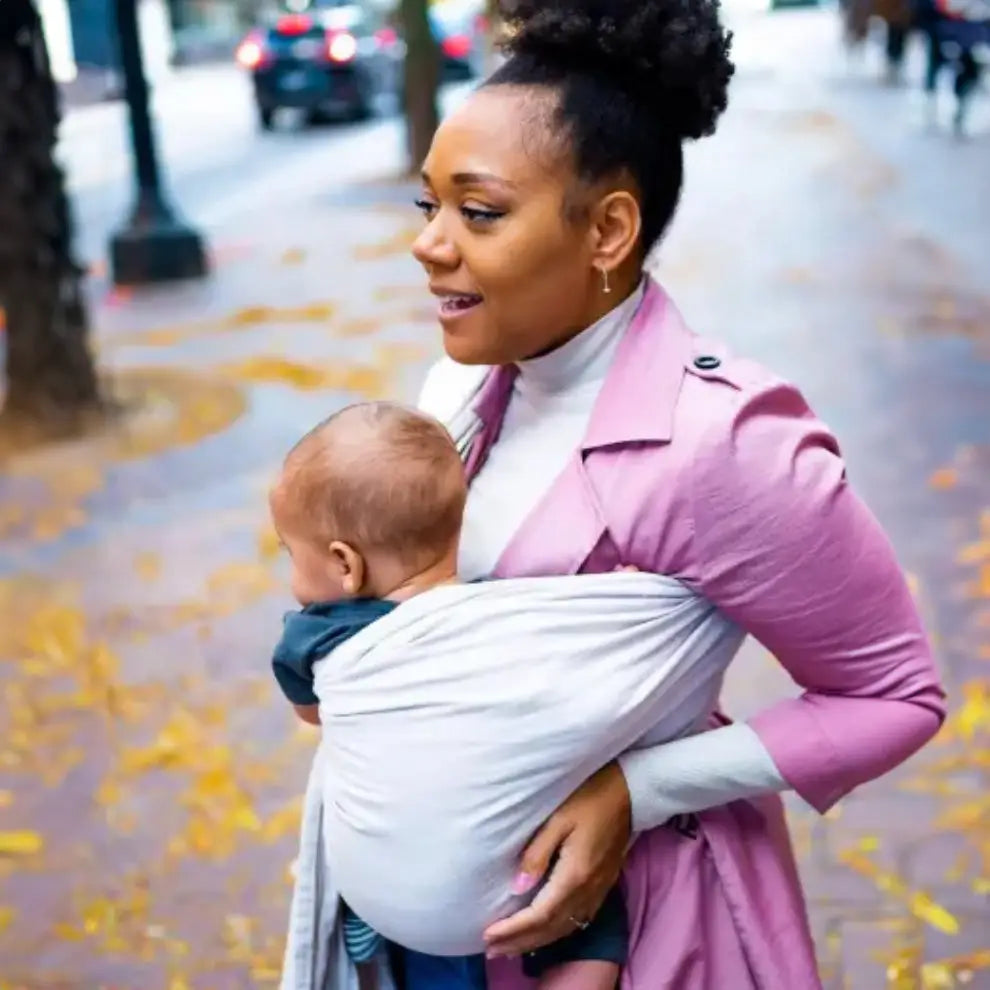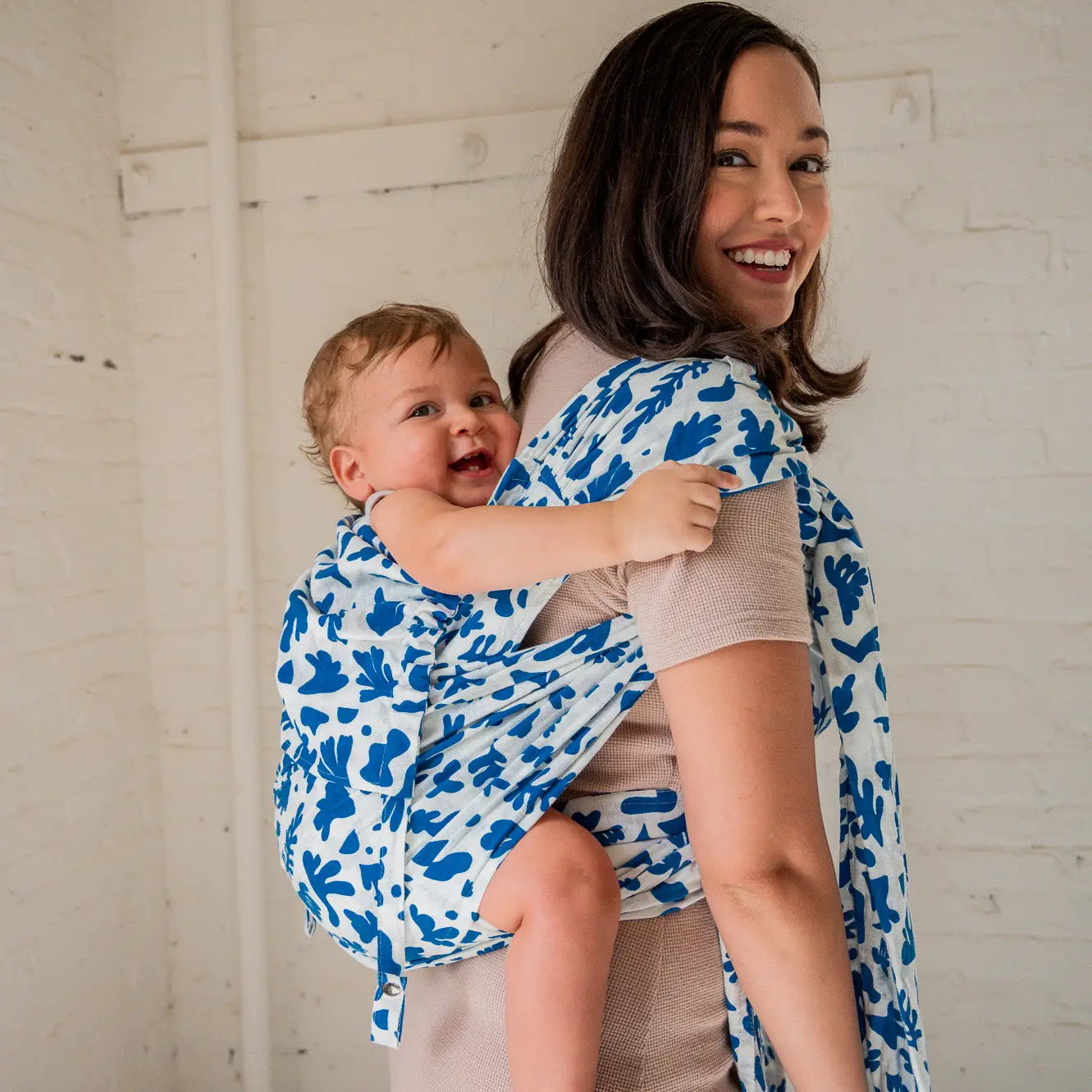Babywearing and Cultural Appropriation from One Black Mother's Point of View
By Caroline J Sumlin
I always knew about babywearing.
I just didn’t know it was “called” babywearing. I always knew about babywearing because I knew that it was a very traditional practice in African culture. As a Black woman, knowing a bit about African culture has always been important to me because the Black culture that we know today is rooted in African traditions and traditions from slavery. In a world that has tried to steal our identity for centuries, we’ve had to work twice as hard to create a culture that honors our roots while acknowledging our present and looking forward to our future.
I was raised in a very “pro-Black” home. What does that mean, exactly? It means that my mom always educated me about the fact that I was Black and that being Black meant that we had African heritage to be proud of. She decorated our home with Black and African artwork, she put me in different activities with majority Black kids, and we went to a historically Black church that hosted recurring African culture days where we were encouraged to wear our African garb to church. When I was about 9, I began studying African culture for myself. I became rather obsessed with it. I learned about various African traditions and looked at photographs of mothers in Africa wearing their babies on their backs in beautiful, traditional African fabric. In fact, my mom had a painting in our home of a mother carrying her son on her back in a traditional African sling. I read books, watched movies, wore African clothes, and asked my mom if we could celebrate Kwanzaa. I’m not entirely sure what prompted me to get so serious about studying African culture at such a young age, but I chalk it up to a childhood identity crisis. All of my Caucasian friends knew what their ancestry was (Irish, German, etc.), but, like most Black people in this country, I never knew what my direct ancestry was. I just knew that I was African American and that I wanted to know for myself exactly what that meant. I wanted to be proud of my heritage.
Fast forward about 20 years
I’m getting ready to become a mother. I’m browsing through my registry options and I come across a wrap for wrapping your baby to your body very similar to what I had seen in photos of African mothers wearing their babies. My initial thoughts were, “Oh, look! A variation of cultural babywearing!” By then, I knew that wearing your baby in a sling or a wrap was a traditional part of many indigenous cultures around the world. They don’t use fancy slings or materials. They use the fabric that is indigenous to their culture to wear their babies. I always thought of American babywearing as the larger carriers with the buckles that you see in all of the baby stores. I was excited to find a wrap that I could purchase that would allow me to practice a more traditional form of babywearing that also allowed me to feel closer to my African heritage and closer to my baby. I put the wrap on my registry.
Fast forward to having my second baby and becoming more immersed in the world of Instagram and discovering small shops that create beautiful products for mothers and children and I discovered the ring sling. I was excited at first. “Yay!,” I thought to myself. “This resembles traditional babywearing even more and seems a bit easier than the wrap!” I purchased my first ring sling before the arrival of my second baby.
But, then I began to notice something.
As I connected with more mothers online, discovered more companies that created slings and wraps for babies, and discovered the rhetoric around babywearing within these communities, my spirit grew frustrated. For something that is so obviously traditional to indigenous cultures around the world, why was babywearing marketed as this “new discovery” in the world of Instagram? And, why did most of the marketing material lack representation of women of color, whose cultures are the ones that “created” babywearing in the first place? Why was no one discussing the history of babywearing in their content and marketing materials? And, most importantly, why were all of the successful companies not employing women of color to make sure that the traditions of babywearing were honored and respected?
And, then it hit me. We’ve seen this time and time again. This was an example of cultural appropriation.
Let’s take a moment to define cultural appropriation.
“Cultural appropriation refers to the use of objects or elements of a non-dominant culture in a way that doesn't respect their original meaning, give credit to their source, or reinforces stereotypes or contributes to oppression.” (Source: Verywell Mind)
This is something that we see frequently in our western society. Most of the “culture” that we consider American is appropriated from the very communities that America has marginalized. From music to fashion, things do not become “trendy” in our society until the dominant culture deems it so. Usually, this comes with very little to no respect for the original culture or original meaning of that thing that has now become trendy.
A good example of this is the traditional cornrow hairstyle that has been worn in the Black community for centuries. Black people have been braiding their hair as a way to protect their hair, manage and maintain their hair, stay connected to their African roots, and even escape from slavery during that time period. However, Black hair, especially cornrows, has been deemed inappropriate, unprofessional, and even “ghetto” in our society. That is...until some people that are a part of the dominant culture began wearing the style a few years ago and even marketed it as a “new discovery.” Now, that very hairstyle that has been traditional to the Black community for ages, yet has been banned from professional settings, the Army, and the like, is now considered trendy because the dominant culture “discovered it” and said it was so. This is cultural appropriation. (TIME.com)
Let’s bring this back to babywearing.
Babywearing, a very traditional, cultural practice, did not become trendy in our society until it was “discovered” and marketed as a “new” beautiful way to connect with your baby. This trend began to rise with the rise of attachment parenting. (Bear and Bundle)
Let’s take a look at a little bit of the history of babywearing,
and more specifically the ring sling.
Mothers have been carrying their babies with wraps and slings within cultures around the world for thousands of years. The babywearing we know today did not arrive on the scene until the 1960s. A woman named Ann Moore was serving in the Peace Corps in West Africa and saw how African women traditionally carried their babies. She returned to America and created the Snugli, which was the first baby carrier to become popular in America. (Source: Babywearing.co.uk)
Moore was a nurse when she served in the Peace Corps in Togo, West Africa. She says that she learned more from African mothers than they learned from her.
“For thousands of years, women around the world have carried their babies close to them," says Moore. "But in America it was considered a radical idea at first. Now we call it 'bonding.' And studies show that babies who are held close to their mothers develop language skills more quickly and are more self-confident.
"In Africa, mothers stay at the hospital to be with their sick babies and it is so comforting to them," says Moore. "Later on, American hospitals accepted this idea and called it 'rooming in.' So in many ways those developing countries are way ahead of us in terms of 'human-ness.'" Ann More (Innovative Lives)
It wasn’t until the 1980s that the babywearing trend took off in the way we see it today. In 1981, a man invented the ring sling for his wife by taking a piece of cloth and two shower curtain rings. This man sold his ring sling to Dr. William Sears who coined the term “attachment parenting” and a new wave of parenting and babywearing was born. (Source: Time Magazine and Bear and Bundle)
Prior to the 1980s, babywearing, breastfeeding, and other natural parenting practices were seen as practices for the poor. The rise in strollers in both the UK and the United States and the parenting philosophies of the 50s and 60s that taught mothers to not “spoil” their babies caused babywearing to be a practiced that was looked down upon. Even though Ann Moore had created the Snugli in the 60s, babywearing in the 60s, 70s, and 80s was seen as either hippy-ish or for the poorer communities.
Let’s pause for a second.
Notice anything? Notice how even babywearing was looked down upon? Notice how it was viewed as something that marginalized communities practiced because they didn’t have access to the “modern” technology of strollers and infant seats? This is exactly what happened with the Black hair example I mentioned earlier. The cultural practice was originally marginalized, seen as “less-than,” and looked down upon by the dominant culture until someone from the dominant culture realizes the brilliance of the very practice and, through their power, creates an acceptable trend and markets it as “new.”
Cultural appropriation.
You might be thinking, “So, what do we do about this?
Do we all have to stop wearing our babies now that we have learned this history?”
Not at all. Just think about how much of a disservice we would be doing for our babies. Babywearing works. It is one of the best things we can do for our children. The indigenous cultures around the world have known this all along. We’re just the ones who are late to the game. Please do not stop wearing your baby.
What we need to do is give honor where honor is due.
Let’s go back to that definition of cultural appropriation. “...the use of objects or elements of a non-dominant culture in a way that doesn't respect their original meaning, give credit to their source…”. It’s time to give credit to the many beautiful, traditional cultures of color around the world that were the originators of babywearing before babywearing ever became a trend. It’s time to include this history in marketing materials and other babywearing content. It’s time to make sure that we stop talking about babywearing as if, with the rise of wraps and ring slings, it was created by white Americans. It wasn’t.
Sorry Dr. Sears, but you are not the inventor of babywearing.
It’s time to make sure that people of color are more than 50% represented in the marketing materials within the different companies that create modern-day wraps and slings. It’s time to put women of color in leadership positions in every babywearing company and community and amplify their voices. Last, but not least, it’s time to THANK every single beautiful indigenous community for paving the way for babywearing and every other natural motherhood practice that has finally made its way to “trending” in western society.
Babywearing is a such beautiful thing. And, we are beautiful mothers carrying our beautiful babies. That won’t ever change. However, we do have the power to make sure that the erasure of the origins of babywearing stops here.



